|

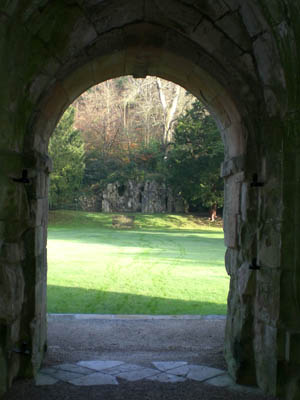 Old Wardour Castle Grotto
Old Wardour Castle Grotto
Nr Tisbury
Wiltshire
United Kingdom
SP3 6RR
Telephone: +44 (0) 1747 870487
The Grotto of Old Wardour Castle was the last addition to the landscape. It was built in 1792 by Josiah Lane of Tisbury, who at the time was a well-known builder of garden ornaments and other grottos in the area. He was commissioned to build the artificial cave, complete with dripping water, fossils and ferns from brick, plaster and stone from the ruins of the castle. The grotto and related structures also incorporates three prehistoric standing stones, removed from the stone circle at Tisbury.
Sequencing Images:
1. The grotto viewed through the Castle Entrance Doorway
2.3.4. The grotto stonework
5. Arms above the castle entrance
6. Old Castle Ruin.
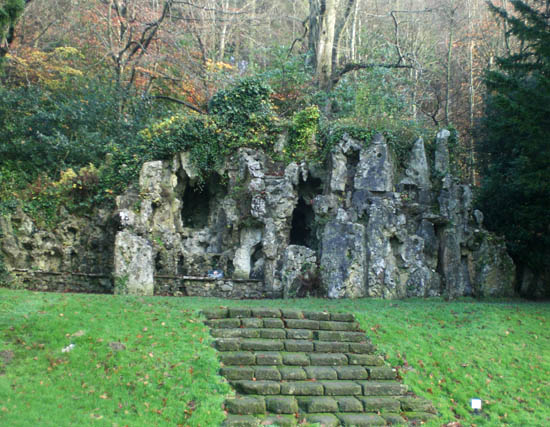
The Grotto at Old Wardour Castle
Today the unusual hexagonal ruins of Old Wardour Castle stand serenely in their lakeside setting, protected by acres of wood. This was not always the case and the ruin testifies to bitter disputes in the past.

The Castle viewing the least damaged aspect
The original castle was built in the 14th century as a lightly fortified luxury residence for comfortable living and lavish entertainment. Following the demise of the Lovell family the castle was confiscated in 1461 and passed through several owners until bought by Sir Thomas Arundell of Lanherne in 1544. Unfortunately the castle was confiscated when Sir Thomas, a staunch Roman Catholic, was executed for treason in 1552. However in 1570 was bought back by his son, Sir Matthew Arundell. Thomas Arundell, 1st Baron Arundell of Wardour, subsequently became one of the most active of the Catholic landowners in England at the time of the Reformation. On 2 May 1643 Sir Edward Hungerford, with 1,300 men of the Parliamentarian Army, demanded admittance to search for Royalists. 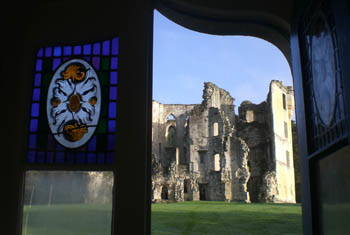
The most damaged side of the castle
He was refused and laid siege, setting about the walls with guns and mines. After five days the castle was threatened with complete destruction. The occupants agreed to surrender, and the castle was placed under the command of Colonel Edmund Ludlow. Lord Arundell had died of his wounds after the Battle of Lansdowne, and his son, Henry 3rd Lord Arundell, next laid siege to his own castle. He blew up much of it and obliged the Parliamentary garrison to surrender in March 1644.
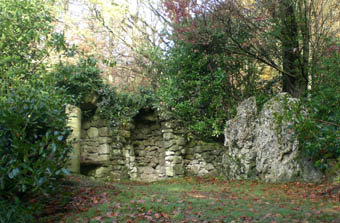
The Rock Shelter near the grotto
The family slowly recovered power and wealth, until the eighth Baron, Henry Arundell, borrowed sufficient funds to finance rebuilding. This was done by the prominent Palladian James Paine. Paine who built a new residence which was called Wardour New Castle. The building of the house was begun in 1769 and completed in 1776. The New Castle is not a castle at all, but a symmetrical neoclassical country house. 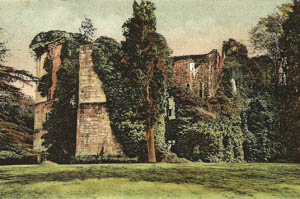
The Castle as a twentieth century Romantic Ruin
Paine then integrated the ruins of the Old Castle into the surrounding parkland, intending it to be viewed as a romantic ruin. Since World War II the New Castle has served as a school and is now divided up into residentail accommodation.
The grounds containing Old Wardour Castle ruins and the grotto are open to the public on set times.
ADDITIONAL INFORMATION
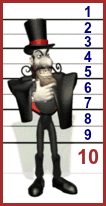

GREAT BRITISH GROTTO GRADING
Click to go to Grotto.Directory home page
CONSTRAINTS
Open set times only
FACILITIES
Access by Road, Access on Foot, Grotto with extensive rock gardens, Restaurant/Food, Toilets, Weddings venue
LANDSCAPE
Country town/village, Park or Garden
REGION
England - Southern
THE FEATURES PRESENT
+Cared for and maintained in good condition, +Dark and mysterious chambers and cave like spaces, +External rock structures, either real or simulated, +Internal stonework that is natural, recycled or simulated to give a subterranean decor, +Stunning setting and location, +Viewing points from within to an intriguing landscape outside, GRADED SIX
|









